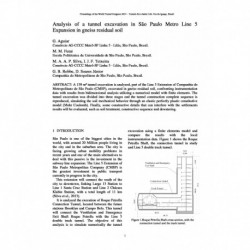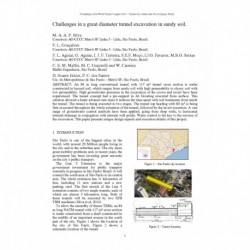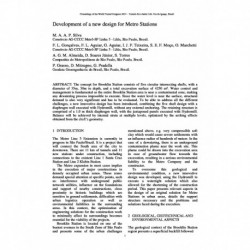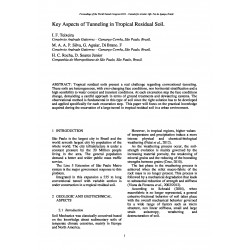No document
Search & filter
Search for a publication
Search & filter
List of products by author: D. Soares Júnior
-
Analysis of a tunnel excavation in São Paulo Metro Line 5 Expansion in gneiss residual soil
Abstract: A 139 m² tunnel excavation is analyzed, part of the Line 5 Extension of Companhia do Metropolitano de São Paulo (CMSP), excavated in gneiss residual soil, confronting instrumentation data with results from bidimensional analysis utilizing a numerical model with finite elements. The tunnel excavation was divided into three stages and the tunnel construction complete sequence is reproduced,...
0,00 € -
Challenges in a great diameter tunnel excavation in sandy soil
Abstract: An 84 m long conventional tunnel with 117 m² tunnel cross section is under constructed in layered soil, which ranges from sandy soil with high permeability to clayey soil with low permeability. High groundwater pressures in the excavation of the crown and invert have been experienced. The tunnel concept had a pre-support in Jet Grouting executed from surface. This solution allowed a faster...
0,00 € -
Development of a new design for Metro Stations
Abstract: The concept for Brooklin Station consists of five circular intersecting shafts, with a diameter of 35m, 30m in depth, and a total excavation surface of 4250 m². Water control and management is fundamental as the entire Brooklin Station area is near a contaminated zone, making any dewatering process impossible to execute. Since the water level is near the surface, structural demand is also very...
0,00 € -
Key Aspects of Tunneling in Tropical Residual Soil
Abstract: Tropical residual soils present a real challenge regarding conventional tunneling. These soils are heterogeneous, with ever-changing face conditions, non horizontal stratification and a high sensibility to water content and transient conditions. At each excavation step the face conditions change, demanding a careful approach in terms of ground treatments and dewatering systems. The...
0,00 €




